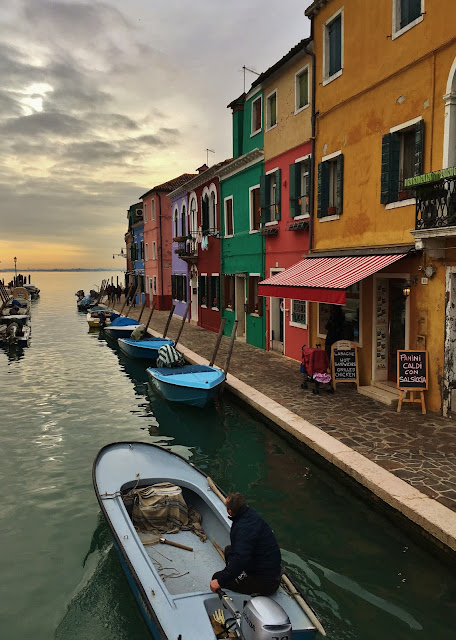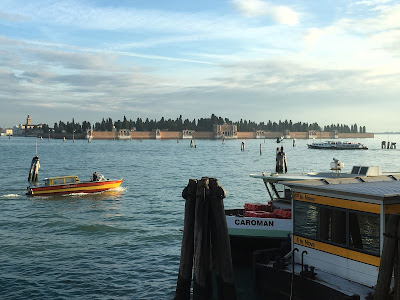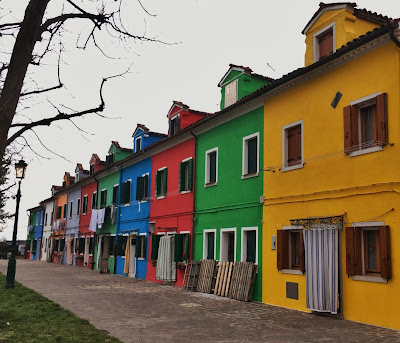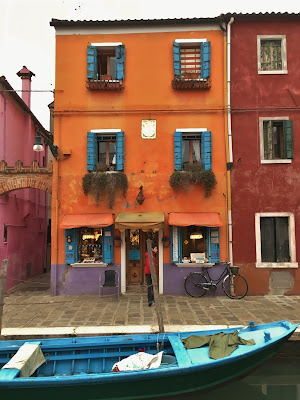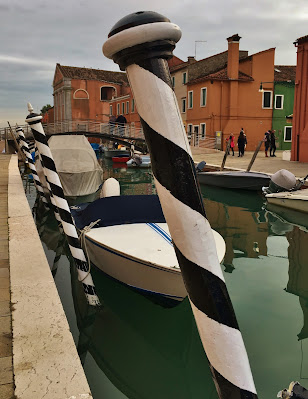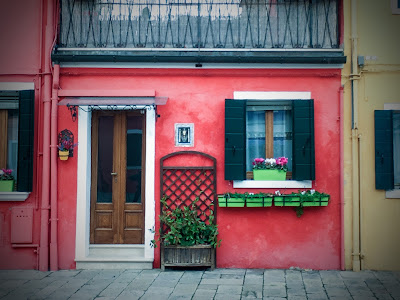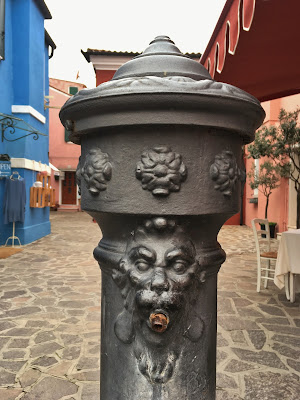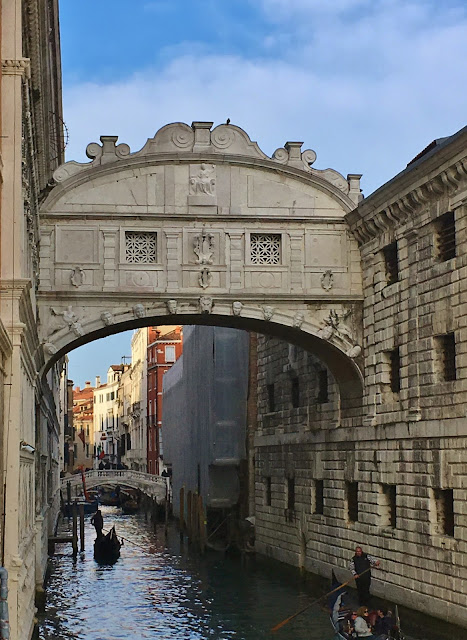"Doge" is a Venetian dialect word mean Duke and the Doge was the elected ruler of Venice. The Doge's Palace was the home for the Doges of Venice and the government from about 1150 to 1550 back when Venice was a Republic. It's hard to believe that the frilly pink palace of the Doge housed some of the most ruthless government leaders and iron-fisted rulers in the Venetian Empire. Venice was called "
La Serenissima" or
"The Most Serene Republic," but in reality, Venice was a super-power not to be reckoned with.
The style of the Palazzo Ducale is Venetian Gothic found only in Venice and the Croatian coast and nowhere else in the world. The palace was built to exude wealth and power so that all that arrived in Venice would pass by this impressive building and know who and what they were dealing with.
The Palazzo Ducale was initially built in 810, but what you see today is from the 1300's and beyond. Much of the original Palace has been destroyed by various fires and rebuilt over the years.
Once you enter the palace and find your way into the Istrian stone courtyard, you can't help but feel an intense sense of awe. The courtyard intersects with St. Marks Basilica, which used to be the Doges private chapel (I am sure there is a secret entrance into the church). The two wells in the centre of the courtyard go back to the 16th century when this courtyard was built. This inner square has seen every dignitary who came to see the Doge. The impressive staircase in the back right corner is called "The Giant's Staircase "and was where the Doges were crowned.
 |
| Scala dei Giganti |
 |
| Courtyard Details |
The Giant's staircase was added to the courtyard in 1485 when the council decided that the Doge and his aides should never descend the stairs. It did not matter if you were a King, Emperor or Pope YOU would have to climb up the stairs to meet the Doge under the statue of the winged lion, the symbol of St. Mark and of Venice. The staircase is flanked by figures of Mars on the left and Neptune on the right, representing Venices power to crush its enemy by land or sea. A wee bit intimidating, to say the least!
 |
| The Mouth of Truth |
Up the staircase and just outside the entrance to the Doges apartments is a strange looking plaque with Latin writing. It is a face with an open mouth that functions as a letterbox. It is called "The Mouth Of Truth," and it is designed as an anonymous note depository for anyone who wanted to report a suspicious act or complaint about another person. There were several of these letterboxes in the palace and around Venice many of them shaped like lion heads and were known as the "
bocche dei lione." This was an excellent way to rid your self of enemies and competitors and a great way to spread fear and paranoia amongst your people to keep them in line. Just sayin'...
 |
| Scala d'Oro |

Once inside the palace you ascended yet another staircase built to impress. The "
Scala d'Oro" or Golden Staircase is the 24-karat gilded ceiling that leads to the Doges private apartments where your eyes will feast upon masterpieces by Veronese, Tintoretto and a few remaining Titian paintings. Titian was THE Rennaisannce heavyweight painter in Venice like Michelangelo was in Rome. Titian painted the Doges Palace with legendary works of art, but unfortunately, multiple fires in 1547, 1574 and 1577 destroyed Titians work and the apartments were painted over by Tintoretto.
I loved touring the rooms and seeing the paintings with details of women's dress of the era; because the silk trade was so vital to Venice's economy. The city of Venice was always portrayed as a beautiful blonde woman, and Veronese used paint pigments from made from jewels and precious stones such as sapphires and emeralds to paint Venice in the latest silk fashions.
 |
| Tintoretto's Paradice and Veronese's Venice |
 |
| Grand Council Room |
Every room in the Palace is a feast for your eyes, but the Hall of the Grand Council or "
Sala del Maggiore Consiglio" is the show stopper. The room is covered with oil paintings including Tintoretto's
Paradiso, the most extensive oil painting in the world with 500 figures. All of the art in the Doges Palace is oil painting and not fresco because the plaster would not be able to handle the humidity of Venice. On the ceiling near Tintoretto's masterpiece is the bright and beautiful painting by Veronese depicting Lady Venice being crowned by angels, becoming a Goddess. The ceilings of the Grand Council room are floodlight by huge lamps so you can see all the gorgeous details of these brilliant Renaissance paintings.
A good guidebook (I used Rick Steves Pocket Venice) can point out the subtleties of the art's symbolism and tell you a bit more about the personal stories of these artists, paintings and landmarks putting it all into a historical context that is relevant to understanding Venice itself.
 |
| Crossing The Bridge Of Sighs |
There are so many rooms to gawk at each with jaw-dropping art that is in situ (meaning the art was created for the space that it sits in currently). We had seen the good, now we must understand the bad and the ugly; the weapons and the prison. There is the Armoury Museum housed in the Palace where there is a
vast display of weapons and sets of armour from Venice's past. This makes one realize how vital Venice's military prowess was for all the trade of silks and spices. These rooms are much smaller and therefore more crowded, so we went through this part of the museum quickly and on to the prison.
 |
| Checking Out The Prison Cells |
There are dungeons below the Palace to hold prisoners, but by the end of the 1500's the Mouth of Truth worked so well that the jails were full of Venice's political prisoners and a new prison had to be built. A new facility was built across the canal from the Doges Palace connected by a limestone covered bridge built in 1600; The "
Ponte dei Sospiri" or Bridge of Sighs. Crossing this bridge from inside was an experience that makes the hair on the back of your neck stand up. As you cross the bridge from the palace into the prison you can
feel the centuries of fear, panic and death of the prisoners; bouncing around in the stone cells. Cassanova spent time here in the prison's upper cells called the "
Piombi" (and made a daring escape), but the lower level cells are called "the wells" and are notoriously damp and overcrowded. The centuries of graffiti left by prisoners that carved messages into the walls of the stone cells was a sobering reminder of how harsh life was in the 17th and 18th century Venice. It was time to leave; grateful that we were just visitors here in the prisons and not inmates.
For a less crowded view of the Bridge of Sighs go to the
Ponte Canonica, one bridge to the North of the Palace. Of course, the best place to view the Bridge of Sighs is from the
Ponte Della Paglia a bridge just to the left of the Palazzo Ducale if you are facing the lagoon. Here you can stand at the rail of the bridge and take in one of Venice's most iconic views as Cassanova, Byron, and Shelley and countless other artists, poets and Romantics (with a capital R) did. There is a favourite gondola stop here that will take you on a half hour canal ride that starts off by gliding under the Bridge of Sighs. There is also a widespread legend:
If lovers kiss on a gondola at sunset under the Bridge of Sighs as the bells of St Mark's Campanile toll, the lovers will be given eternal love.
 |
Soak Venice in like a sponge; the history, the beauty and the romance. |
Follow me on INSTAGRAM and FACEBOOK for daily photos!








